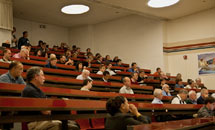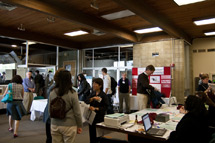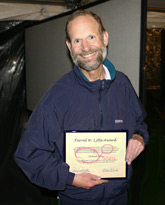
Handy Links
SLAC News Center
SLAC Today
- Subscribe
- Archives: Feb 2006-May 20, 2011
- Archives: May 23, 2011 and later
- Submit Feedback or Story Ideas
- About SLAC Today
SLAC News
Lab News
- Interactions
- Lightsources.org
- ILC NewsLine
- Int'l Science Grid This Week
- Fermilab Today
- Berkeley Lab News
- @brookhaven TODAY
- DOE Pulse
- CERN Courier
- DESY inForm
- US / LHC
SLAC Links
- Emergency
- Safety
- Policy Repository
- Site Entry Form

- Site Maps
- M & O Review
- Computing Status & Calendar
- SLAC Colloquium
- SLACspeak
- SLACspace
- SLAC Logo
- Café Menu
- Flea Market
- Web E-mail
- Marguerite Shuttle
- Discount Commuter Passes
-
Award Reporting Form
- SPIRES
- SciDoc
- Activity Groups
- Library
Stanford
Around the Bay
SSRL/LCLS Users' Meeting Wraps Up Today
The SSRL/LCLS Users' Meeting and Workshops are finishing up today following three full days of presentations. More than 250 participants from around the world attended the meeting, which updated users on facility capabilities and performance at SLAC, highlighting 35 years of fantastic research at the Stanford Synchrotron Radiation Lightsource, the start of user science at Linac Coherent Light Source and the importance of user safety while using SLAC X-ray facilities.
"The SSRL/LCLS Users' Meeting and Workshops is a way to get users to come together and talk about what they are doing," said SLAC physicist Sebastien Boutet, one of the program chairs for the event.
The event launched with a pre-meeting symposium on Sunday, October 18, Advances in Lightsource Science–Past, Present and Future, in honor of SLAC and Stanford physicist Sebastian Doniach, who served as the founding director of the Stanford Synchrotron Radiation Lightsource. Thirty-five years later, SSRL continues to produce fantastic results.
"2009 has been a great year for SSRL," SSRL Acting Director Piero Pianetta said. "Our uptime was 99%, better than ever before in SSRL history." In addition, Pianetta discussed excellent user satisfaction at SSRL and new upgrades in the beamlines that will allow SSRL to run at higher intensities as the year progresses.
Joachim Stöhr, director of the LCLS, briefly outlined the powerful capabilities of the new facility and took a minute to celebrate the start of user science—officially called "user assisted commissioning," a close collaboration between LCLS staff scientists and researchers from other institutions to perform the machine's first experiments, to explore and fine-tune its capabilities. Being careful not to steal any user's thunder by prematurely announcing results, Stöhr moved quickly to outlining future plans. One goal is for SLAC facility users to have a "one stop shop," as Stöhr called it, when arriving to SLAC. A single front office would welcome users and provide safety training for SSRL or LCLS, helping streamline user check-in for both facilities. Stöhr also outlined potential upgrades to LCLS over the next two, five and ten years.
"In the near term, we want to increase user capacity; we want all of you to get your hands on the beam," he said. Stöhr's list of long-term goals for the expansion of LCLS facilities included possibly adding a second injector and a lower-energy beamline.
While celebrating the milestones of SSRL and LCLS, Pianetta, Stöhr and SLAC director Persis Drell emphasized the importance of safety at SLAC as a part of the brilliant research that occurs at the facilities. "It is not safety or science," Drell said, "it's safety and science."
After the opening talks, the presentations moved to more specific presentations by SSRL and LCLS users. "The scientific talks are highlights of what users have achieved during the past year," said SSRL senior scientist and meeting organizer Donghui Lu. Two such talks were given by Yulin Chen, who at the meeting received the Spicer Award for his work in material sciences on topological insulators; and Leslie Jimison who accepted the Klein Award for her materials science research on semiconducting polymers.
The Farrel Lytle Award was presented on Monday night to SSRL Senior Scientist Mike Toney. The prize works to foster collaboration between SSRL users and staff, and recognizes an individual who has made significant technical or scientific contributions in synchrotron radiation-based science. Mike Toney received the award for his outstanding support of user science programs and innovation in the use of X-ray scattering in organic thin films and other energy-related materials. Although he was not able to attend in person, Farrel Lytle sent a letter congratulating Mike.
Today, meeting participants are attending break–away sessions. "The workshops provide a more focused discussion on a particular topic," said program chair Boutet. Instead of a short, thirty minute presentation on a specific topic, the sessions allow more in-depth coverage of particular areas including SSRL imaging techniques, large-molecule crystallography, the LCLS beamline for soft X-ray science and the preparation of an X-ray pump–probe instrument at LCLS. These sessions enable collaboration on aspects of SSRL or LCLS that researchers may be interested in using in the future. This collaboration and feedback is one way that SLAC can gauge users needs for the future.
"We have a lot of science to do together," Drell said. "Let us know what we can do to help you get the science out."
—Lauren Knoche
SLAC Today, October 21, 2009


